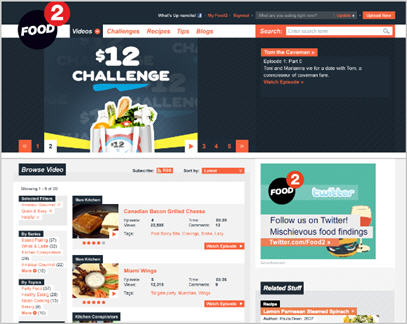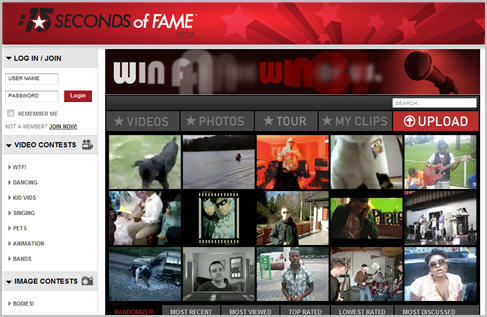-
15 Seconds of Fame (15sof.com): A Broadband, Social Media-Based Version of "American Idol"
Andy Warhol's famous quote that "everyone gets their 15 seconds of fame" is the inspiration behind a new web site called 15sof.com that is like a broadband, social media-based version of the hit show "American Idol," but created and promoted at a fraction of the cost.
15sof.com is meant to capitalize on the growing subculture of society (that tends to skew younger) who are either seeking fame and fortune or want to influence the process of who attains it. These motivations have been the key forces behind the explosion of reality-based contest shows now running and arguably drive many of the most outlandish stunts seen on YouTube.
15sof.com's founder/CEO John Bonaccorso explained to me that the site offers aspiring contestants a simple but novel proposition: pay $1 to submit your 15 second (max) video to one of the myriad contests running at any one time on 15sof.com. The community then votes on the submissions and moves a handful of contestants on to subsequent rounds where lengthier videos are accepted. The prize money is funded from the contestants' fees. Contestants can enter as often as they'd like, but precautions are in place to prevent voting fraud. 15sof uses a white-label social media platform from Reality Digital, which I last wrote about here.
With current top prizes in the $25-$100 range, nobody's going to get rich, but they will gain visibility and of course psychic gratification. As John explained, particularly for the high school and college-aged drama crowd, 15sof.com offers them an opportunity to show their stuff, which is plenty enough.
15sof.com is itself a pure social media creation: John said the site hasn't spent any money yet on conventional marketing. Instead it has built awareness and participation solely through Facebook, MySpace, Twitter and other social media platforms. In the world of 15sof.com - and many other social sites and apps launching today - there's no need for tune-in ads, billboards or other expensive marketing tactics. Sites like 15sof.com grow out of the burgeoning social community, dominated by the young. John wouldn't disclose numbers, but said the site beat its first month traffic goal in the first 3 weeks. That's no indication of future success, but it's a good start.
For me, there are 2 other noteworthy aspects of 15sof.com. First, the site reflects yet another example of "purpose-driven" user-generated video, a concept I've explored in the past in connection with Unigo, a start-up trying to use student-created videos to disrupt the college guidebook industry. The "purpose-driven" video idea is to get the multitudes of amateurs whom YouTube introduced to video to turn their newfound skills and passion toward something more remunerative and possibly productive. Purpose-driven video concepts are proliferating. Most notable are the myriad brand-sponsored consumer video contests and also the many sites featuring user-created how-to videos. I continue to believe there will be many bona fide business opportunities based on purpose-driven video.
Second, 15sof.com also illustrates the evolving interplay between online and on-air programming. We are starting to see how programs born in one of the mediums can create a variation in the other, or where a concept can migrate from one medium to the other. For example, John's vision is that 15sof.com - the spawn of American Idol - could itself eventually become a TV show. Another example of this phenomenon is Scripps Networks' Food2, where new talent being showcased could eventually graduate to programs on the Food Network itself. I suspect some of this multi-platform thinking is behind Ben Silverman's new venture with IAC. My point is that broadband is giving programmers a lot of new flexibility in how they bring their creative concepts to market.
Meanwhile, if you're expecting to find yours truly belting out a song on 15sof.com, you'll have to keep waiting. I'll be here hiding behind my keyboard.
What do you think? Post a comment now.
Topics: 15sof.com, Food2, Reality Digital, YouTube
-
Food2: A New Example of How Cable Networks Leverage Broadband
(note: I've been under the weather this week, which explains yesterday's absence of VideoNuze. I'm getting back on my feet and hope to be resuming regular publication)
Late last week Scripps Networks, parent of cable networks Food Network, HGTV, FLN and others, launched Food2, a web site targeting the 21-34 demo. Scripps has long been a leader among cable networks in capitalizing on online/broadband's potential, and this newest entry is yet another example of how important broadband is to cable networks' future growth. I spoke with Bob Madden, GM of Food's online properties to learn more.
First and foremost, Food2 is distinguished by its focus on the 21-34 demo. One of the interesting things about Food Network on air has been its appeal to younger audiences (this will likely resonate with those of you who have teenagers). But based on research it conducted Food executives realized that - no surprise - younger audiences want to experience food-related content in different ways: with shorter form non-linear content, more emphasis on experimental tastes and increased access to social/content sharing tools.
So Food2 was conceived as an effort to "super-serve" this audience. Scripps defines Food2 as "designed to be a social experience - just like food itself. It's the intersection of food, drink and pop culture." With a heavy emphasis on Facebook/Twitter integration, tons of short videos featuring hip young culinary talent and original webisodes plus challenges, recipes and tips, Food2 seeks to live up to its goal of experiencing food through the eyes of millennials.

To me, Scripps' real insight from a business perspective is recognizing that broadband creates new "shelf space" for them to launch properties that target specific audiences and in turn specific advertisers seeking to reach those audiences. This matters a lot because due to existing contracts with cable/satellite/telco operators, cable networks have been constrained, at least relative to broadcast networks, in their ability to fully distribute online their popular full length programs (for example, there is no Food Network content on Hulu). While these contracts have led cable networks to achieve highly stable financial performance in this rocky economy, it has deprived them of fully serving their audiences.
Food2 demonstrates that there's online value to be built separate and aside from simply distributing full-length programs online. And because Food2 will be promoted on Food Network's air, and will have some of its advertising sold in packages with Food Network and other Scripps properties, it is off to a running start. Lastly, while Scripps doesn't want Food2 to be seen as a "farm team" for Food Network, there's no question that if talent gets traction on Food2, it has the potential to migrate to the 90M homes that Food Network is carried in, offering lots of interesting upside.
Food2 is a tangible example of a traditional media company recognizing that younger audiences want to consume media differently and that broadband is a new kind of medium that can serve them accordingly. With practically all cable networks savoring access to younger audiences, I expect Food2 will be watched by others and eventually spawn similarly targeted sites.
What do you think? Post a comment now.
Categories: Cable Networks
Topics: Food Network, Food2, Scripps Networks
Posts for 'Food2'
|



